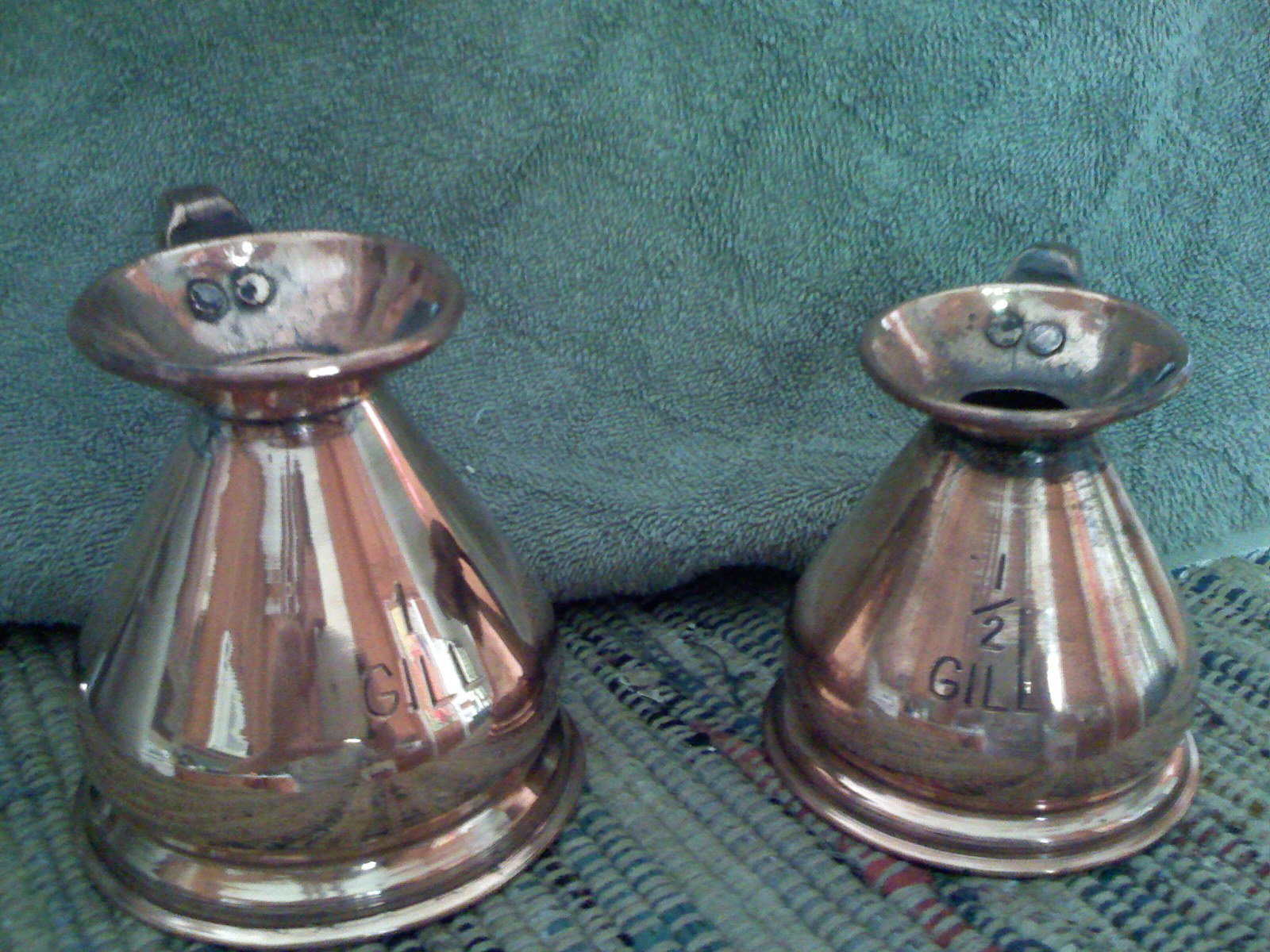|
Pint (Scots)
The joug or scottish pint () was a Scottish unit of liquid volume measurement that was in use from at least 1661 – possibly as early as the 15th century – until the early 19th century, approximately equivalent to 1696 mL or roughly three imperial pints. The standard was held at Stirling and thereby called the Stirling Jug. It went astray in 1745 and its loss was hidden by replacement by a standard pewter jug of roughly the same size. The error was discovered by Rev Alexander Bryce in 1750, who after a long search found the damaged jug in the attic of a Mr Urquhart, a coppersmith in Stirling, and restored the standard. Bakers used the measure until the late 19th century. * One joug was sixteen Scottish gills (of approximately 106 mL each) * One joug was four mutchkins (of approximately 424 mL each) * One joug was two chopins (of approximately 828 mL each) * Eight jougs made a Scottish gallon (approximately 13.568 L) See also * Obsolete Scottish uni ... [...More Info...] [...Related Items...] OR: [Wikipedia] [Google] [Baidu] |
Scotland
Scotland (, ) is a country that is part of the United Kingdom. Covering the northern third of the island of Great Britain, mainland Scotland has a border with England to the southeast and is otherwise surrounded by the Atlantic Ocean to the north and west, the North Sea to the northeast and east, and the Irish Sea to the south. It also contains more than 790 islands, principally in the archipelagos of the Hebrides and the Northern Isles. Most of the population, including the capital Edinburgh, is concentrated in the Central Belt—the plain between the Scottish Highlands and the Southern Uplands—in the Scottish Lowlands. Scotland is divided into 32 administrative subdivisions or local authorities, known as council areas. Glasgow City is the largest council area in terms of population, with Highland being the largest in terms of area. Limited self-governing power, covering matters such as education, social services and roads and transportation, is devolved from the Scott ... [...More Info...] [...Related Items...] OR: [Wikipedia] [Google] [Baidu] |
Stirling
Stirling (; sco, Stirlin; gd, Sruighlea ) is a city in central Scotland, northeast of Glasgow and north-west of Edinburgh. The market town, surrounded by rich farmland, grew up connecting the royal citadel, the medieval old town with its merchants and tradesmen, the Old Bridge and the port. Located on the River Forth, Stirling is the administrative centre for the Stirling council area, and is traditionally the county town of Stirlingshire. Proverbially it is the strategically important "Gateway to the Highlands". It has been said that "Stirling, like a huge brooch clasps Highlands and Lowlands together". Similarly "he who holds Stirling, holds Scotland" is often quoted. Stirling's key position as the lowest bridging point of the River Forth before it broadens towards the Firth of Forth made it a focal point for travel north or south. When Stirling was temporarily under Anglo-Saxon sway, according to a 9th-century legend, it was attacked by Danish invaders. The sound of a ... [...More Info...] [...Related Items...] OR: [Wikipedia] [Google] [Baidu] |
Alexander Bryce (minister)
Alexander Bryce (1713–1786) was a Church of Scotland minister, mathematician, astonomer, scientist and poet who was Chaplain in Ordinary to King George III from 1770 to 1786. He was a polymath and a friend of Robert Wallace and Colin Maclaurin. In 1772 he explained the principles of creating an altimeter ultimately put into use to create the instruments. Life He was born at Boarland in Kincardine-on-Forth in 1713. He was educated at both Doune and Kilmadock School. He graduated MA from Edinburgh University in 1735. From 1740 he acted as a private tutor in mathematics and astronomy (under patronage of Colin Maclaurin) in the Caithness area for three years where he became locally unpopular for mapping and tabulating shipwrecks on the coast in an attempt to prove a higher than expected number as evidence of "wreckers". He was licensed to preach by the Presbytery of Dunblane in June 1744. In August 1745 he was ordained as minister of Kirknewton Parish Church under the p ... [...More Info...] [...Related Items...] OR: [Wikipedia] [Google] [Baidu] |
Gill (unit)
__NOTOC__ The gill or teacup is a unit of measurement for volume equal to a quarter of a pint. It is no longer in common use, except in regard to the volume of alcoholic spirits measures. ;In imperial units: : ;In United States customary units: : In Great Britain, the standard single measure of spirits in a pub was in England, and in Scotland, while the was also a common measure in Scotland, and still remains as the standard measure in pubs in Ireland. After metrication, this was replaced by measures of either , at the discretion of the proprietor. A spirit measure in the Isle of Man is still defined as . Half of a gill is a jack, or an eighth of a pint. But in northern England, a quarter pint could also be called a jack or a noggin, rather than a gill, and in some areas a half pint could be called a gill, particularly for beer and milk. In Ireland, the standard spirit measure was historically gill. In the Republic of Ireland, it still retains this value, though it ... [...More Info...] [...Related Items...] OR: [Wikipedia] [Google] [Baidu] |
Mutchkin
''Disambiguation: a "mutchkin" can also refer a close-fitting Scottish cap''. The mutchkin ( gd, mùisgein) was a Scottish unit of liquid volume measurement that was in use from at least 1661 (and possibly as early as the 15th century) until the late 19th century, approximately equivalent to 424 mL, or roughly imperial pint. The word was derived from – a mid 15th-century Dutch measure of beer or wine. *A mutchkin could be subdivided into four Scottish gills (of approximately 106 mL each) – this was roughly equivalent to three imperial gills or three-quarters of an imperial pint. *Two mutchkins (848 mL) made one chopin. *Four mutchkins (1696 mL) made one Scottish pint (or ''joug''), roughly equivalent to three imperial pints (1705 mL).* See also * Obsolete Scottish units of measurement Scottish or Scots units of measurement are the weights and measures peculiar to Scotland which were nominally replaced by English units in 1685 but continued ... [...More Info...] [...Related Items...] OR: [Wikipedia] [Google] [Baidu] |
Chopin (unit)
The chopin was a Scottish measurement of volume, usually for fluids, that was in use from at least 1661, though possibly 15th century, until the mid 19th century.* The measurement was derived from the French measure ''chopine'' an old and widespread unit of liquid capacity, first recorded in the 13th century. A chopin is equivalent to 0.848 litres. * 1 chopin is 8 gills * 1 chopin is 2 mutchkins * 2 chopins is the equivalent of 1 (Scots) pint (or joug) * 16 chopins is the equivalent of 1 (Scots) gallon References See also * Obsolete Scottish units of measurement Scottish or Scots units of measurement are the weights and measures peculiar to Scotland which were nominally replaced by English units in 1685 but continued to be used in unofficial contexts until at least the late 18th century. The system was ... Obsolete Scottish units of measurement Units of volume 17th-century establishments in Scotland 17th-century introductions 19th-century disestablishments in Scotland ... [...More Info...] [...Related Items...] OR: [Wikipedia] [Google] [Baidu] |
Gallon (Scots)
The Scots gallon ( gd, galan) was a unit of liquid volume measurement that was in use in Scotland from at least 1661 – and possibly as early as the 15th century – until the late 19th century. It was approximately equivalent to 13.568 litres, or very roughly three times larger than the Imperial gallon that was adopted in 1824. A Scots gallon could be subdivided into eight Jougs (or Scots pints, of 1696 mL each), or into sixteen chopins (of 848 mL each). An ale or beer barrel was 12 Scots gallons (35.81 Imperial gallons 62.816 litres. Articles of Union (1707), Article VII (tax on liquor). ''That all parts of the United Kingdom be for ever from and after the Union lyable to the same Excises upon all Exciseable Liquors excepting only that the 34 Gallons English Barrel of Beer or Ale amounting to 12 Gallons Scots present measure sold in Scotland by the Brewer at 9/6d Sterling excluding all Duties and Retailed including Duties and the Retailer's profit at 2d the Scots pint ... [...More Info...] [...Related Items...] OR: [Wikipedia] [Google] [Baidu] |
Obsolete Scottish Units Of Measurement
Scottish or Scots units of measurement are the weights and measures peculiar to Scotland which were nominally replaced by English units in 1685 but continued to be used in unofficial contexts until at least the late 18th century. The system was based on the ell (length), stone (mass), and boll and firlot (volume). This official system coexisted with local variants, especially for the measurement of land area. The system is said to have been introduced by David I of Scotland (1124–53), although there are no surviving records until the 15th century when the system was already in normal use. Standard measures and weights were kept in each burgh, and these were periodically compared against one another at "assizes of measures", often during the early years of the reign of a new monarch. Nevertheless, there was considerable local variation in many of the units, and the units of dry measure steadily increased in size from 1400 to 1700... The Scots units of length were technical ... [...More Info...] [...Related Items...] OR: [Wikipedia] [Google] [Baidu] |
Units Of Volume
A unit of volume is a unit of measurement for measuring volume or capacity, the extent of an object or space in three dimension (mathematics), dimensions. Units of capacity may be used to specify the volume of fluids or bulk goods, for example water, rice, sugar, grain or flour. Units According to the International System of Units, SI system, the base unit (measurement), base unit for measuring length is the metre. The SI unit of volume is thus the cubic metre, which is a derived unit, where: at nist.gov. Retrieved 29 June 2022. 1 m3 = 1 m • 1 m • 1 m. Comparison Forestry and timber industry British Commonwealth * Hoppus, cubic foot measure used in the Brit ...[...More Info...] [...Related Items...] OR: [Wikipedia] [Google] [Baidu] |





